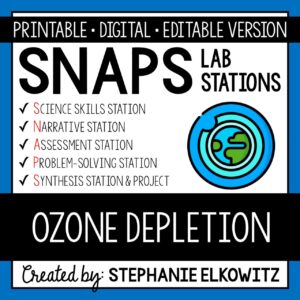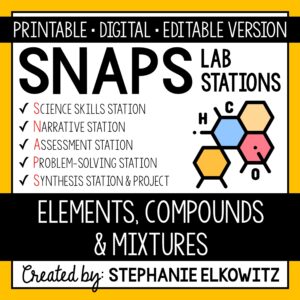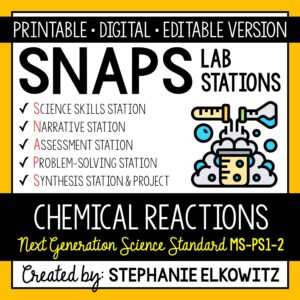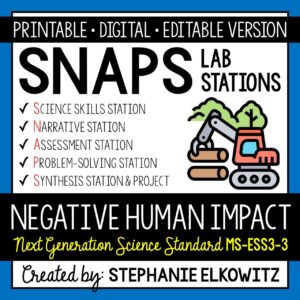5-LS1-1 Plant Needs Lab
$7.00
An engaging lab activity designed to enhance students’ understanding of the importance of air, water and soil in plant growth. Aligned with NGSS 5-LS1-1.
Description
5-LS1-1 Plant Needs Lab Preview
SNAPs Lab Stations Activities require students to use science, math, literacy, problem-solving and engineering skills. They are designed to enhance students’ understanding of scientific concepts and help students apply scientific ideas to the real world. Each station activity promotes skills so to develop students into proficient and competent scientific thinkers.
SNAPs lab activities have five components:
• Science Skills Station to develop science skill proficiency
• Narrative Station to build science literacy
• Assessment Station to evaluate learning and understanding
• Problem-Solving Station to foster engineering design
• Synthesis Station and Project to inspire higher-order learning
DIGITAL LABORATORY – DISTANCE LEARNING & DIGITAL CLASSROOMS
• This lab is offered in a digital format to support digital classrooms & distance learning.
• The digital lab activity is designed to work with Google Slides and Microsoft PowerPoint
• The digital lab activity CANNOT be edited. However:
– Students can manipulate text boxes
– Students can create tables, graphs and diagrams
– Students can insert images and drawings
GOOGLE FORM ASSESSMENT STATION
• The assessment station is offered as a self-grading Google Form.
• Questions are all short answer and are 100% editable.
• Suggestions for use are included in the download.
DISTANCE LEARNING COMPATIBILITY
SNAPs lab activities are rated for their ease with distance – independent learning. Refer to the preview for more information about how well this laboratory works in a fully digital classroom and with distance learning.
EDITABLE DOCUMENTS
This download includes an editable word document (docx file) of all lab components:
• Pre-Lab and Post-Lab Activities
• The Lab Overview
• Lab Station Activities and Questions
• Directed Synthesis Project (when applicable)
Important Notes:
• Diagrams, illustrations, tables and graphs essential to lab activities are included
• Illustrative clipart is NOT included
• Editable documents and rubrics are included with the FREE SNAPs Setup Guide
Editable files allow you to:
• Edit the scope of the activities so to suit your students’ needs
• Edit the materials required based on resource availability
• Create single-period “mini-labs” using activities at the individual skills stations
The activities at each station in this lab are detailed below.
Plant Needs Lab Learning Objectives
1. Identify the materials necessary for plant growth.
2. Explain the importance of air and water in plant growth.
3. Discuss how plant structures enable a plant to obtain the substances it needs to grow and survive.
4. Debate the significance of soil in proper plant growth.
5. Evaluate the use of hydroponics in the growth of plants for human consumption.
Science Skills Station
Students will graph the mass of a plant, water and soil within a closed system over a period of time. From the data, students will determine the source of important substances needed for plant growth. Students will design an experiment to confirm their conclusions.
Narrative Station
Students will read an informational text about plant needs. Students will read about the substances necessary for proper plant growth. Students will also watch a video about plant needs, how plants obtain the materials they need to survive and the importance of soil in plant growth and survival.
Assessment Station
At this station, students will answer questions about key terms and ideas relating to plant needs and the materials necessary for plant growth. Students must employ lower, mid and higher order thinking skills to answer these questions.
Problem-Solving Station
Students will study and evaluate a hydroponics system. Students will watch a video about hydroponics and a video that compares the growth of a pepper plant in soil to a pepper plant grown in a hydroponics system. Students will evaluate the use of hydroponics.
Synthesis Station
Students will compose a CER (claim-evidence-reasoning) report to summarize the lab. Students are provided the claim statement and must support the claim with observations, data and other information gathered in the lab. Students will explain how the evidence supports the claim using scientific reasoning.
Synthesis Project
Students will have a choice of 11 projects. Refer to the SNAPs Lab Stations Best Practices and Setup Guide for directions and suggestions on how to conduct the project.
Directed Synthesis Project
Students can conduct one of the 11 standard synthesis projects, but I strongly suggest using the directed synthesis project to best summarize the information in this lab. In the directed project, students will design, build and test a hydroponics system using materials available at home or in your classroom. Students will design and build a prototype in which to grow a seedling. Students will also test their hydroponics system and measure the growth of the plant over a 3-week period.
This download includes:
• A pre-lab assignment and post-lab reflection
• Directions and questions for each lab station
• Student recording sheets
• Teacher Key
Additional Materials Required:
Computer or tablet
1 Flowering plant
Magnifying glass
Ruler
Pan
If performing the directed synthesis project in class you will also need:
Empty plastic bottles (such as soda or water bottles)
Paper or plastic cups (various sizes – from 3 oz to 16 oz)
Filter paper
Felt
Cotton balls
Small rocks (such as aquarium rocks)
Duct tape
Scissors
Seedlings (small plants)
Hydroponic nutrient solution
LINKS TO VIDEOS
This laboratory requires internet to access videos. Videos are hosted on SafeShare.TV so to safely watch and share educational YouTube videos without ads, comments and other distractions. Full and shortened links to original YouTube videos are included.
NEXT GENERATION SCIENCE STANDARDS
This laboratory satisfies NGSS 5-LS1-1. It combines the three dimensions of science learning – science and engineering practices, disciplinary core ideas and crosscutting concepts – to meet the standard. This lab also makes interdisciplinary connections to STEM, Math CCSS and ELA CCSS to build the appropriate skills.
TERMS OF USE
• All rights reserved by Stephanie Elkowitz.
• This product is to be used by the original purchaser only.
• Intended for classroom and personal use only.
• Copying for more than one teacher, classroom, department, school, or school system is prohibited.
• This product may not be distributed or displayed digitally for public view.
• Failure to comply is a copyright infringement and a violation of the Digital Millennium Copyright Act (DMCA).








